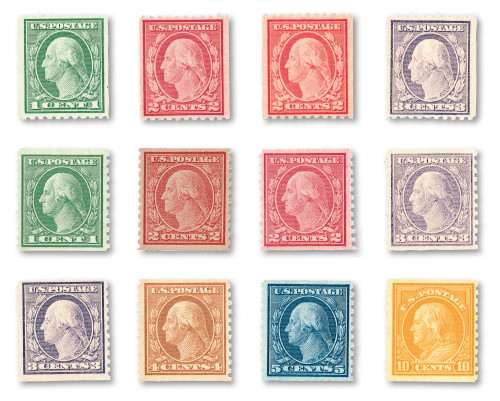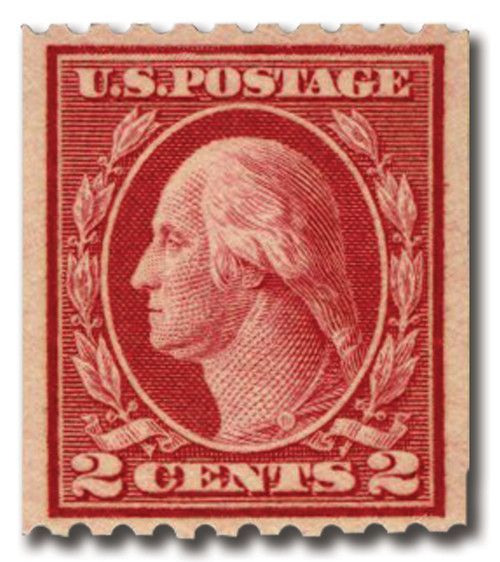
# 486-89 - Complete Set, 1916-18 Rotary Press Coils Perforated 10 Horiztontally
Are You Missing These Series of 1916-17 Washington-Franklin Coils?
Unwatermarked, Perforated 10 Horizontally
The Washington-Franklins are among the most fascinating and challenging US stamps to collect. Issued between 1908 and 1922, they encompassed over 200 varieties, five different designs, two paper types, three printing methods, at least 14 perforations, several colors, and 20 denominations.
You can come one step closer to completing your Washington-Franklin collection with this convenient set of 4 stamps. The BEP switched to unwatermarked paper in 1916 in a move to save money. US aid to Europe during World War I, as well as the country’s expected entry into the war, made such cost-cutting moves practical.
These stamps were all printed on unwatermarked paper. US #486-89 were perforated 10 horizontally. Set includes:
US #486 – The first horizontal coil, unwatermarked, perf. 10, created on 170-subject plates.
US #487 – Printed on Type II plates. Identified by: the left ribbon has only one line on the top fold (Type III has two); the strand of hair between the ear and cheek has a pronounced, curved outline on the bottom; the shaded area above Washington’s eye pushes upwards; a line on the right-hand ribbon appears as three dashes; shading lines in his hair, and in the laurel leaves, are often more pronounced than in Type I stamps, but less pronounced than Type III.
US #488 – When the Type II plates used to produce the earlier 2¢ Washington stamp wore out, officials switched to Type III plates. The deeper cuts in the plates resulted in a new type of stamp – #488. There were a lot more Type III stamps issued than Type II. Some of the primary features of the Type III Rotary Press Washington stamps are: the left ribbon has two shading lines on the top fold; there are also two shading lines in the last fold of the right ribbon; the bottom two strands of hair behind Washington’s ear extend past the vertical strands to their right; the top right laurel berry shows a distinct “V.”
US #489 – Printed on Type I plates. Distinguished by: a pronounced white line underneath Washington’s ear, and the bottom two strands of hair behind his ear are shorter than the ones above it. Other features are often less distinct than found on Type II or Type III dies.
Are You Missing These Series of 1916-17 Washington-Franklin Coils?
Unwatermarked, Perforated 10 Horizontally
The Washington-Franklins are among the most fascinating and challenging US stamps to collect. Issued between 1908 and 1922, they encompassed over 200 varieties, five different designs, two paper types, three printing methods, at least 14 perforations, several colors, and 20 denominations.
You can come one step closer to completing your Washington-Franklin collection with this convenient set of 4 stamps. The BEP switched to unwatermarked paper in 1916 in a move to save money. US aid to Europe during World War I, as well as the country’s expected entry into the war, made such cost-cutting moves practical.
These stamps were all printed on unwatermarked paper. US #486-89 were perforated 10 horizontally. Set includes:
US #486 – The first horizontal coil, unwatermarked, perf. 10, created on 170-subject plates.
US #487 – Printed on Type II plates. Identified by: the left ribbon has only one line on the top fold (Type III has two); the strand of hair between the ear and cheek has a pronounced, curved outline on the bottom; the shaded area above Washington’s eye pushes upwards; a line on the right-hand ribbon appears as three dashes; shading lines in his hair, and in the laurel leaves, are often more pronounced than in Type I stamps, but less pronounced than Type III.
US #488 – When the Type II plates used to produce the earlier 2¢ Washington stamp wore out, officials switched to Type III plates. The deeper cuts in the plates resulted in a new type of stamp – #488. There were a lot more Type III stamps issued than Type II. Some of the primary features of the Type III Rotary Press Washington stamps are: the left ribbon has two shading lines on the top fold; there are also two shading lines in the last fold of the right ribbon; the bottom two strands of hair behind Washington’s ear extend past the vertical strands to their right; the top right laurel berry shows a distinct “V.”
US #489 – Printed on Type I plates. Distinguished by: a pronounced white line underneath Washington’s ear, and the bottom two strands of hair behind his ear are shorter than the ones above it. Other features are often less distinct than found on Type II or Type III dies.








